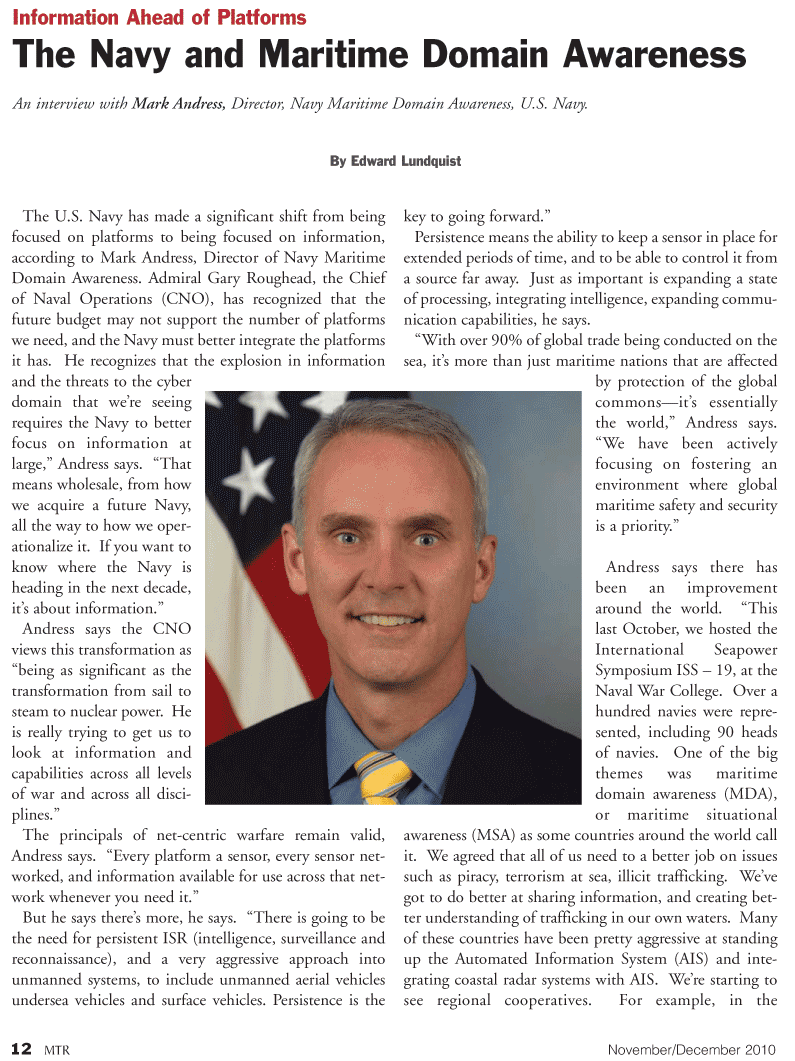
Page 12: of Marine Technology Magazine (November 2010)
Fresh Water Monitoring and Sensors(lakes, rivers, reservoirs)
Read this page in Pdf, Flash or Html5 edition of November 2010 Marine Technology Magazine
12 MTR November/December 2010
The U.S. Navy has made a significant shift from being focused on platforms to being focused on information, according to Mark Andress, Director of Navy Maritime
Domain Awareness. Admiral Gary Roughead, the Chief of Naval Operations (CNO), has recognized that the future budget may not support the number of platforms we need, and the Navy must better integrate the platforms it has. He recognizes that the explosion in information and the threats to the cyber domain that we’re seeing requires the Navy to better focus on information at large,” Andress says. “That means wholesale, from how we acquire a future Navy, all the way to how we oper- ationalize it. If you want to know where the Navy is heading in the next decade, it’s about information.”
Andress says the CNO views this transformation as “being as significant as the transformation from sail to steam to nuclear power. He is really trying to get us to look at information and capabilities across all levels of war and across all disci- plines.”
The principals of net-centric warfare remain valid,
Andress says. “Every platform a sensor, every sensor net- worked, and information available for use across that net- work whenever you need it.”
But he says there’s more, he says. “There is going to be the need for persistent ISR (intelligence, surveillance and reconnaissance), and a very aggressive approach into unmanned systems, to include unmanned aerial vehicles undersea vehicles and surface vehicles. Persistence is the key to going forward.”
Persistence means the ability to keep a sensor in place for extended periods of time, and to be able to control it from a source far away. Just as important is expanding a state of processing, integrating intelligence, expanding commu- nication capabilities, he says. “With over 90% of global trade being conducted on the sea, it’s more than just maritime nations that are affected by protection of the global commons—it’s essentially the world,” Andress says. “We have been actively focusing on fostering an environment where global maritime safety and security is a priority.”
Andress says there has been an improvement around the world. “This last October, we hosted the
International Seapower
Symposium ISS – 19, at the
Naval War College. Over a hundred navies were repre- sented, including 90 heads of navies. One of the big themes was maritime domain awareness (MDA), or maritime situational awareness (MSA) as some countries around the world call it. We agreed that all of us need to a better job on issues such as piracy, terrorism at sea, illicit trafficking. We’ve got to do better at sharing information, and creating bet- ter understanding of trafficking in our own waters. Many of these countries have been pretty aggressive at standing up the Automated Information System (AIS) and inte- grating coastal radar systems with AIS. We’re starting to see regional cooperatives. For example, in the
Information Ahead of Platforms
The Navy and Maritime Domain Awareness
An interview with Mark Andress, Director, Navy Maritime Domain Awareness, U.S. Navy.
By Edward Lundquist

 11
11

 13
13
